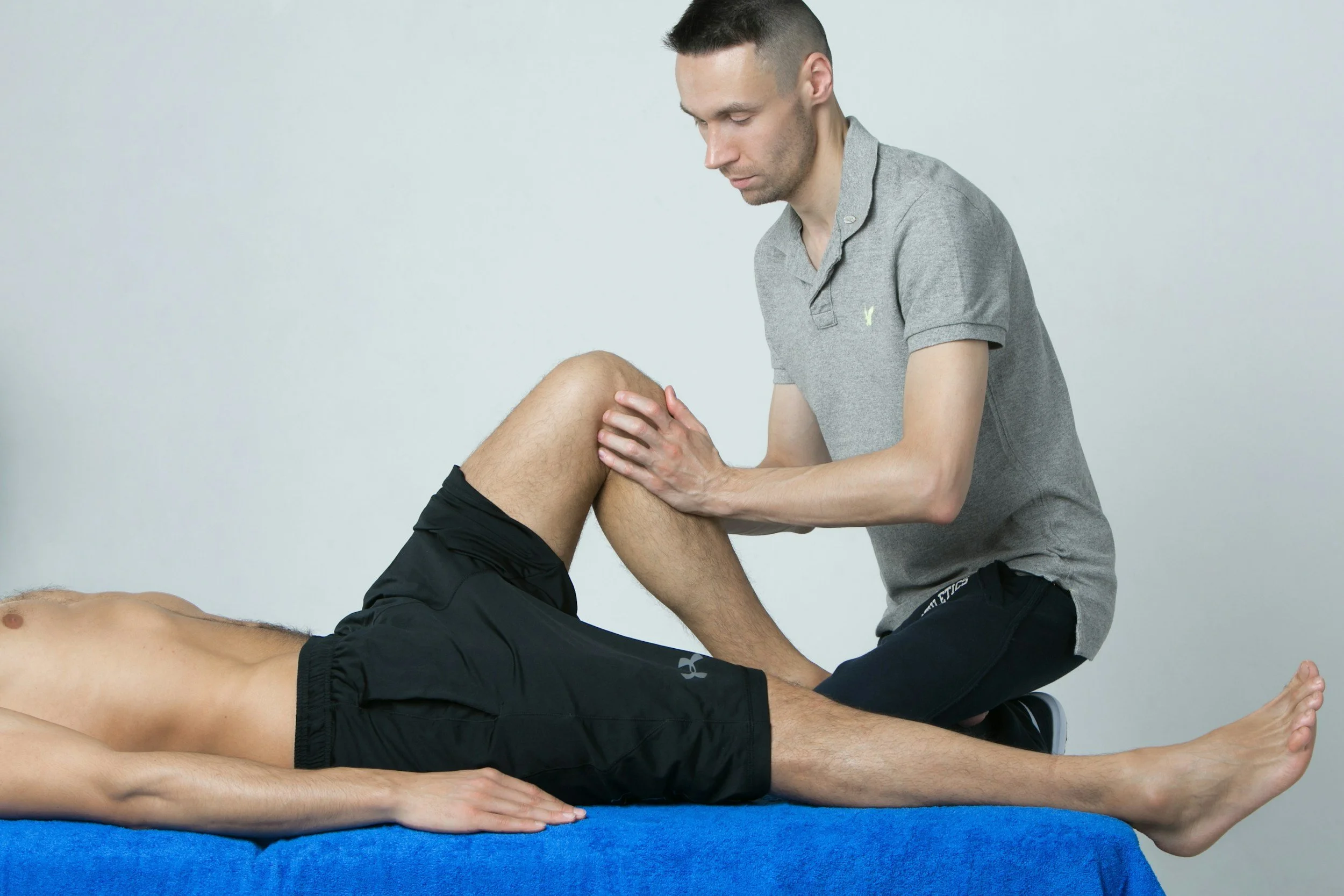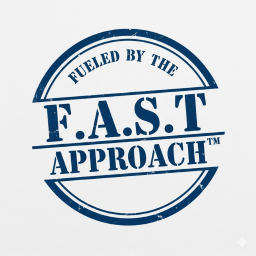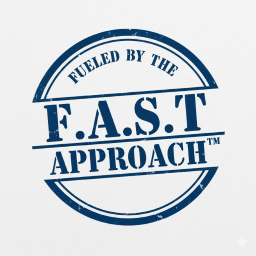
F.A.S.T Approach™
The F.A.S.T Approach™ is a proprietary system for physical therapists, designed to improve the consistency and accuracy of clinical reasoning, treatment and recovery. It empowers clinicians to quickly differentiate diagnoses and accelerate treatment.
At its core, the F.A.S.T Approach™ provides a structured framework for rapidly and precisely addressing the root cause of a patient's movement limitations. This system moves beyond a symptom-based approach, focusing instead on targeted evaluation and treatment that streamlines the entire process.
The F.A.S.T Approach™ revolutionizes physical therapy by addressing the root cause of pain from a mechanical movement dysfunction: restricted joint movement. Through gentle, targeted micromovements, we restore the natural rolling motion of the joints. This releases tension in surrounding tissues (muscles, fascia, tendons), allowing them to return to their optimal length. The result? Pain-free movement, increased activity levels, and the ability to Play Every Day!
-
-
Lesson 1: What is the F.A.S.T Approach™?
At its core, the F.A.S.T Approach™ provides a structured framework for rapidly and precisely addressing the root cause of a patient's movement limitations. This system moves beyond a symptom-based approach, focusing instead on targeted evaluation and treatment that streamlines the entire process.
At its core, the F.A.S.T Approach™ provides a structured framework for rapidly and precisely addressing the root cause of a patient's movement limitations. This system moves beyond a symptom-based approach, focusing instead on targeted evaluation and treatment that streamlines the entire process.
-
Lesson 2: How We Move
Our understanding of human movement is key to recognizing why a system is needed to address a movement dysfunction. In this lesson, we'll explore the foundational principles of how we move, setting the stage for learning the FAST Approach™, a framework for diagnosing and treating movement dysfunction.
Our understanding of human movement is key to recognizing why a system is needed to address a movement dysfunction. In this lesson, we'll explore the foundational principles of how we move, setting the stage for learning the FAST Approach™, a framework for diagnosing and treating movement dysfunction.
-
Lesson 3: Neural Control of Movement
We will define Neural control of Movement in relation to the Musculoskeletal System because this concept is the core of Facilitation, Activation, Systematic Therapy. (F.A.S.T Approach™)
We will define Neural control of Movement in relation to the Musculoskeletal System because this concept is the core of Facilitation, Activation, Systematic Therapy. (F.A.S.T Approach™)
-
Lesson 4: Movement Dysfunction
In the human body, dysfunction refers to any impairment or abnormality that prevents an organ, system, or tissue from performing its normal, intended function. It's essentially a breakdown in the body's machinery, ranging from minor issues to severe, life-threatening conditions.
In the human body, dysfunction refers to any impairment or abnormality that prevents an organ, system, or tissue from performing its normal, intended function. It's essentially a breakdown in the body's machinery, ranging from minor issues to severe, life-threatening conditions.
-
Lesson 5: Assumptions of Pain
We must be careful to keep these assumptions separate from Objective facts.
We must be careful to keep these assumptions separate from Objective facts.
-
Lesson 6: SOAP Note
We will use the OG SOAP note and go beyond data collection to create a dynamic, useful tool.
We will use the OG SOAP note and go beyond data collection to create a dynamic, useful tool.
-
Bob has shoulder pain.
-
-
-
Lesson 1: Soft Tissue Dysfunction
A soft tissue dysfunction is an impairment or abnormal change in the function of soft tissues, such as muscles, tendons, ligament and organs. These dysfunctions can lead to pain, stiffness, and a reduced range of motion.
A soft tissue dysfunction is an impairment or abnormal change in the function of soft tissues, such as muscles, tendons, ligament and organs. These dysfunctions can lead to pain, stiffness, and a reduced range of motion.
-
Lesson 2: Peripheral Nerve Dysfunction
A peripheral nerve dysfunction will present with three specific signs. It is important not to miss these three signs.
A peripheral nerve dysfunction will present with three specific signs. It is important not to miss these three signs.
-
Lesson 3: Inflammatory Process
When we suggest a systemic inflammatory process we are discussing a rheumatological phenomenon, an immune system deficiency.
When we suggest a systemic inflammatory process we are discussing a rheumatological phenomenon, an immune system deficiency.
-
Lesson 4: Osteoarthritic Change
Osteoarthritic change refers to the degenerative process at a single joint that involves the breakdown of the cartilage that cushions the ends of bones.
Osteoarthritic change refers to the degenerative process at a single joint that involves the breakdown of the cartilage that cushions the ends of bones.
-
Lesson 5: Mechanical Joint Dysfunction
Mechanical joint dysfunction appears as a unilateral decrease of movement accompanied by increased muscle tone, muscle tightness, and muscle inhibition.11
Mechanical joint dysfunction appears as a unilateral decrease of movement accompanied by increased muscle tone, muscle tightness, and muscle inhibition.11
-
-
-
Lesson 1: Subjective
We can take what people say, and how they describe their story, to give us information about the differential.
We can take what people say, and how they describe their story, to give us information about the differential.
-
Lesson 2: Palpation
We can use our skilled hands and feel the tissue for information that will guide our differential.
We can use our skilled hands and feel the tissue for information that will guide our differential.
-
Lesson 3: Neurological Signs
There are three specific neurological signs that we can test for and never miss.
There are three specific neurological signs that we can test for and never miss.
-
Lesson 4: Muscle Resistance
We will take what we learn from a manual muscle test, define the findings a bit further and use the findings to localize our differential. Yes, this is important.
We will take what we learn from a manual muscle test, define the findings a bit further and use the findings to localize our differential. Yes, this is important.
-
Lesson 5: Passive vs Active ROM
We can actually use what we learn from active motion testing and compare it to what we learn from passive motion testing and glean valuable information for our differential. Find out how.
We can actually use what we learn from active motion testing and compare it to what we learn from passive motion testing and glean valuable information for our differential. Find out how.
-
Lesson 6: End Feel
We will get to the end ranges of passive gross motion and use the end feel information to guide our differential. This is also very important.
We will get to the end ranges of passive gross motion and use the end feel information to guide our differential. This is also very important.
-
Lesson 7: Differential Diagnosis of a Movement Dysfunction
Differentiating a movement dysfunction with precision and consistency on every visit is a skill that allows you to move beyond guessing and focus on the true cause of a patient's dysfunction.
Differentiating a movement dysfunction with precision and consistency on every visit is a skill that allows you to move beyond guessing and focus on the true cause of a patient's dysfunction.
-
Lesson 8: Differentiation for Bob
We will continue the Case Study of Bob and his shoulder pain and we will differentiate our findings.
We will continue the Case Study of Bob and his shoulder pain and we will differentiate our findings.
-
-
-
Lesson 1: Mechanical Joint Dysfunction Evaluation
The human body consists of 150 joints that cannot be dissociated from one another regarding overall movement.
The human body consists of 150 joints that cannot be dissociated from one another regarding overall movement.
-
Lesson 2: Treatment of Mechanical Joint Dysfunction
The proper use of physical therapy is to restore function without creating new traumatic pathology.39 The goal is to reestablish normal stresses in order to restore normal structure and function. Find out how.
The proper use of physical therapy is to restore function without creating new traumatic pathology.39 The goal is to reestablish normal stresses in order to restore normal structure and function. Find out how.
-
Lesson 3: Facilitation of Normal Joint Movement
Facilitation of joint movement reestablishes the normal stresses at the articular level to restore normal function.
Facilitation of joint movement reestablishes the normal stresses at the articular level to restore normal function.
-
Lesson 4: How to Facilitation Normal Joint Motion
Facilitating normal joint motion is a manual technique used to restore the preferred path of a joint.
Facilitating normal joint motion is a manual technique used to restore the preferred path of a joint.
-
Lesson 5: Treatment for Bob's Shoulder Pain
We will introduce why facilitating joint motion is very important in fixing Bob’s shoulder pain.
We will introduce why facilitating joint motion is very important in fixing Bob’s shoulder pain.
-
-
-
Lesson 1: Recovery Guidelines
Recovery Guidelines explain to the Client HOW they are getting better. This makes recovery easier and your job as a physical therapist easier too.
Recovery Guidelines explain to the Client HOW they are getting better. This makes recovery easier and your job as a physical therapist easier too.
-
Lesson 2: Recovery Guidelines for Bob
We will introduce why facilitating joint motion is very important in fixing Bob’s shoulder pain.
We will introduce why facilitating joint motion is very important in fixing Bob’s shoulder pain.
-
-

